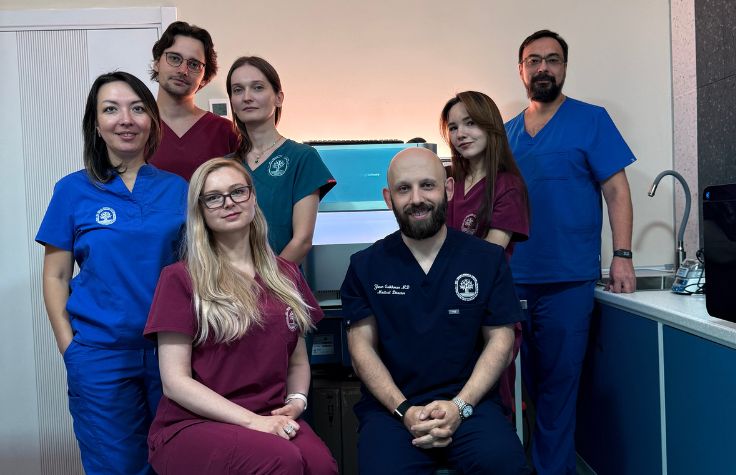
17 July 2024
Not-for-profit Victorian Clinical Genetics Services (VCGS), a subsidiary of Murdoch Children’s Research Institute, provides comprehensive genetic testing, genetic counseling, and clinical services across Australia, and performs all the standard biochemical newborn screening for the State of Victoria, totaling nearly 80,000 babies a year. VCGS also conducts research on pediatric genetic diseases and for emerging applications that may someday translate to a routine test option.
When Associate Professor Sebastian Lunke started working there in 2016, he had just a handful of colleagues in what was then called the Translational Genomics Unit, tasked with building a clinical exome sequencing service. Today, Lunke is executive general manager for Genetic and Genomic Innovation and head of the Division of Genetics and Genomics, which has over 130 people working in three research and clinical lab units.
Part of Lunke’s division focuses on methods research and optimization for rare diseases, serving their mission of using novel technologies to increase the volume and speed of diagnoses. One of its key specialties is ultra-rapid genome sequencing for critically ill children, which was pioneered in the Asia-Pacific region by the Acute Care Genomics research study led by Lunke’s colleague and key collaborator Professor Zornitza Stark.
Through their efforts, Lunke and Stark realized that in some instances, even when they were able to diagnose a child in the Acute Care Genomics study in as little as 48 hours, the child could have gotten the right treatment sooner—and possibly avoided the intensive care unit altogether—if they’d been sequenced as a newborn, before they got sick.
This spurred their interest in genomic newborn bloodspot screening (NBS) and, in mid-2022, they launched BabyScreen+. This pilot research study set out to perform NBS on 1000 babies in addition to standard biochemical newborn screening, aiming for early identification of over 600 treatable childhood-onset conditions under a research protocol. The ultimate goal of this large research initiative is simple—in the future, preventing as many infants as possible from getting sick. They’re also tracking data on the project’s feasibility and implementation, with larger studies in mind for the future. The team began by working out the ethics and building the systems and support infrastructure.
BabyScreen+ research is designed to answer many questions regarding educational and communication challenges (for health professionals, prospective parents, and the public), and best practices for gaining informed consent and other ethical considerations.
Recruitment opened in August 2023, and they approached parents during pregnancy rather than right after birth. A statewide collection system delivers the card from the NBS test for every baby born in Victoria to the VCGS lab, where Lunke’s team will match the cards with the patients whose parents have enrolled in the research study and perform whole-genome sequencing on them.
Some of the questions the BabyScreen+ research study hopes to answer:
- When and how do we best educate and recruit prospective parents?
- What are the perceptions of health care professionals and the public regarding genomic NBS?
- How do we best implement genomic NBS into the Victorian/Australian health care system?
- What is the best way to return the results?
- What do we do if we find a high-chance result?
- How can we use the genome data if a baby returns to the hospital in the future?
Leveraging automation tools
In the Acute Care Genomics research study, VCGS turns a genomics test around in 72 hours, which is incredibly fast. However, more than 40 of those 72 hours are spent obtaining the data. “Once we have the data, we can turn around a result in a matter of hours rather than days,” Lunke says.
VCGS is collaborating with Illumina on the research study, and is using Emedgene software—part of the Illumina Connected Software portfolio that allows for streamlined and automated screening and germline genome interpretation for research—and the first application for a research study of this kind and at this scale. “Certain aspects of what we were trying to achieve here wouldn’t be deliverable with the systems we had,” Lunke says. “In particular, the aspects of scale we need to work towards in genomic screening rely heavily on automation.”
Formerly, analysts would spend hours manually examining this data. This isn’t feasible at the population scale that the future of newborn screening could potentially demand. Lunke cites not just the time, but the cost, which would involve hiring and training people to analyze the datasets.
Screening 1000 newborns will not yield hundreds of high-risk infants, as most single research subject results will be “normal.” The team estimates they’ll only need to closely examine the research data for approximately 2% of the research subjects.
The plan is to automate the analysis and interpretation of what they call “screen-negative cases.” “Emedgene software is a tool designed to deal with whole genomes and large data,” Lunke says. “Importantly, it has extensive application program interface (API) capabilities, which means it can talk to the other software tools at VCGS, in a very efficient but highly secure manner, and coordinate all the information. As soon as we load the sample on the machine, it flows through the interpretation system via the DRAGEN™ secondary analysis software and Emedgene software to automate the lab-defined standardized process.”

VCGS has managed to automate about 70% of screen-negative cases—with a few checkpoints in the process. Ultimately, they want to generate an automatic report for 90%–95% of cases. With representatives from Illumina and Lunke’s bioinformatics team, they worked to integrate the system and implement it. “Once that was ready according to our lab protocols and local requirements, we deployed and launched it and have been running it happily for over a year,” Lunke says. “That automation will help us scale to a much larger level.”
Based on the success they’ve had with Emedgene software in large-scale screening research initiatives, and an uptick in local interest especially for three conditions—cystic fibrosis, spinal muscular atrophy, and fragile X syndrome—they are now transitioning all their expanded carrier screening research workflows to Emedgene.
Thanks to Emedgene software, the talent at VCGS, and the passion of everyone involved, Lunke estimates they will finish recruiting for the BabyScreen+ research initiative by mid-2024. Because they recruit families three to six months before their child’s birth, the researchers expect to wrap up the study toward the end of the year.
BabyScreen+ research will represent a solid, evidence-backed model of what a similar program could look like at the population scale. The next phase of the study might involve sequencing 10,000 babies. Ultimately, VCGS hopes to expand the program to the broader health system and the general population.
An inspired future outlook
With the current standard of care, scientists will look at a patient’s data only when a doctor has a specific question. Lunke says that once they’ve answered that question, the patient’s genetic data goes into a secure archive, stays there, and isn’t accessed again until they have a new question.
Some scientists believe that because sequencing will become cheaper—and cost less than storing data—we should resequence every time a patient gets sick, rather than reanalyze existing data whenever new information and gene discoveries are published. Lunke believes that approach “misses a point—that if you throw the data away, you also throw away the opportunity to integrate updated knowledge and take that much more holistic view.”
For Lunke, the “next essential leap in genomics” is having the data from the beginning. The medium- to long-term goal is to “explore the lifelong health value of that information once we have it.” Ideally, the standard of care would be to sequence every child at birth and keep their genomic data secure as part of their health care record. This could prevent certain diseases and make their data available for use as needed—as long as they or their parents retain control over that usage. The individual should be in control of their data at every stage, whether it’s to ask about their pharmacogenomics, their own reproductive risk in their thirties, or their risk for cancer or heart disease in their forties or fifties.
“Most importantly, it’s about giving agency back to the individual that the genomic data belongs to in the first place,” Lunke says. “They can choose to know or not to know. That’s how I see the future—a truer definition of personalized health care, informed by your genetic makeup.”
Further, Lunke imagines a future when parents routinely have carrier screening for themselves and newborn screening for their children. This is even more powerful than either type of screening alone, and can illuminate health information at both the individual and family levels. “There’s still more to learn. And that’s a good thing. The potential in this space when it comes to genomic screening is mind-boggling. I think we’re only just at the start of teasing out what we can do with all that information. We must ensure that it’s done the right way. Then we can continue to learn new things while bringing everyone along on the journey. Genomics is part of essential, basic health care. We want to build awareness of what we can do to benefit everyone’s health today and for generations to come.”


